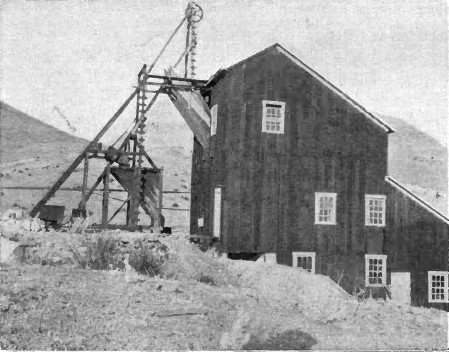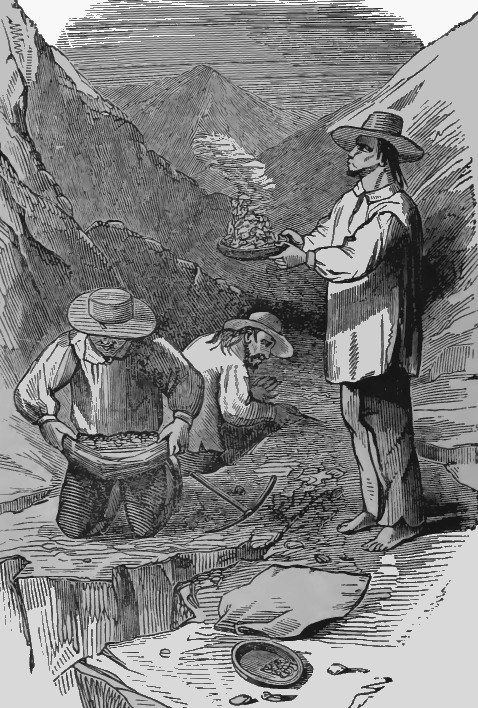The following is a historic article written upon the arrival of the first territorial government in Arizona. It shows just how critically important the placer gold mines were in the formation of the new territory. In fact, numerous attempts had been made by citizens of what is now Arizona, and also citizens of New Mexico, to organize the Territory of Arizona, for which the attempts, up to the winter of 1862-63, did not seem to have been taken seriously by Congress, this territory being considered practically worthless and the home of the wildest set of Indians that ever cursed any portion of the continent, and it is doubtful whether the Territory would have been organized had it not been for the discovery of native gold and silver within its boundaries.
SANTA FE, NEW MEXICO, November 33, 1883.
The officers of the new territory of
Arizona reached here on the afternoon
of the 14th, after a journey of fifty days from
Leavenworth. They were accompanied by an
escort of cavalry, and a heavy train, which rendered rapid travel
impossible. They are in excellent health, and have stood the exposures of
the trip remarkably well. All the way from Fort
Larned they experienced unusually
severe weather for the season, encountering two snow storms, and a
temperature at Fort
Lyon and elsewhere far below the freezing
point. Indeed, the autumn thus far has been one of the coldest known on the
plains for many years, and very tiring to the traveler. Since the arrival of
the party at this place they have been surrounded by snow, and have had to
baffle unusually high winds. Some of the roads leading from Santa Fe have
been quite blocked up with snow. That to the valley
of Taos was for some days impassable.
The erection of Arizona into a distinct territory has attracted especial
attention to a district that was hereto almost a terra incognita. With a
view to facilitate the organization of the civil government, Brigadier
General James H. Carleton, commanding the department, has sent expeditions
to different parts of the territory and established military posts at points
where the Indians were disposed to be troublesome. Before the golden placers
on the upper Gila, and its tributaries, the Aqua Fria, San Francisco and
Salinos, were discovered, he had perfected a plan for the exploration of
that whole country, having no doubt of its auriferous wealth. Few military
officers on the frontier have shown such a praiseworthy determination as his
General Carleton, for twenty years past, to promote the development and
settlement of the domain under be control. His good name must ever be
honorably associated with the territories of New Mexico and Arizona and the
entire Pacific region.
THE NEW GOLD FIELDS:
The most thorough and accurate report of the new and surpassingly rich gold fields of Arizona is given in the letter of Surveyor General Clarke, of this territory, to General Carlton, at whose instance he went from here in July last to examine into and report upon the discoveries, their extent and probable yield. He reached the diggings on the 19th of August, and spent some weeks in visiting and carefully observing the various mining locations. They are mainly upon the western branches of Aqua Fria, which has its rise some fifty miles southwesterly from the San Francisco Mountain (which can be considered the geographical center of the territory), and runs into the Gila river on a line parallel with the Rio San Francisco, and about fifty miles west of that stream. Most of the miners at work on the General's arrival were Californians, who had entered the district from La Paz, on the Colorado River, a distance of some one hundred and fifty miles. A few Sonorans had come up by way of Tubac, Tucson and the Pima Villages, from which latter point the diggings are about one hundred and fifty miles in a direction little west of north.
The placer mines thus far developed extend over a tract of country from twenty to thirty miles in width, and about one hundred and twenty-five in length. On nearly every claim worked to the bed rock gold ore was found in paying quantities. The most remarkable place, discovered by one Jack Swilling, a noted character from this territory, is on the summit of Antelope Mountain, between the Antelope and Indian creeks. Thro is a depression between two rocky peaks, through which the ore is a quartz ledge cropping out. The solid rock on either side of this ledge is covered with a reddish earth a low inches In depth. Swilling had taken twenty thousand dollars worth of the precious gold bearing ore from this place within a few weeks. The specimens shown General Clark were all coarse nuggets. In a parcel worth six hundred dollars he could not find a piece worth less than ten cents, and Swilling had one nugget weighing not quite half a pound. Much of the golden mineral had been dug out with nothing more than a common jack knife, and many of the miners were entirely engaged in dry washing, owing to a lack of water. This would appear to be the principal drawback with which the gold seekers will have to contend. Scarcely one of the many creeks could be depended upon for a supply of water more than sufficient for drinking purposes. How it will be in the worst of the dry season remains to be seen.
It if the prevailing opinion among the miners, and with those here who are familiar with the configuration of the country east of the present diggings, that the gold deposits extend in that direction, and that the richest beds are yet to be discovered. The Indians are said to hold this view, but to show no desire to encourage investigations. Where the miners are now at work the Indians are friendly, and have interposed no interference. It is said that several of the tribes have made a treaty with the white men, not only to permit them to dig wherever they please, but to defend them against the attacks of hostile tribes. The Tonto Apaches live just about the placers, and are entirely different from the Apaches living in the woods from Mesilla Valley to Tucson, whose atrocities drove the Sonora (now Arizona) and d Santa Rita mining companies from operations at Tabac several years since. It is not improbable that as the gold-seekers move eastward they will encounter those inveterate plunderers and assassins, and have to deal them many hard blows before they reform their ways. With the aid of General Carleton they will, however, soon overpower the, tribe, bold and numerous as it is.
THE ROUTES TO THE MINES
To the time of General Clark's visit no one had gone from the East to the
mines. Since then many adventurous spirits have flocked there from this
City, and indeed from every portion of the territory and from Colorado. The
road is by Albuquerque, Fort
Wingate and the Zuni
Pass (the Whipple route) to the San
Francisco Mountains, and thence southwesterly for one hundred miles. The
entire distance from here, as estimated by General Clark, is five hundred
and sixteen miles. There is no post, nor even a ranch, west of Wingate,
which is but ninety miles from the Rio Grande. The road is, however, a very
good one, and for the most part well wooded and watered, while the grass is
generally abundant. Those interested in studying the peculiarities of the
route will find them set forth in Whipple's Report, Volume
III
Pacific Railroad Reports, and in Beale's report of his wagon road
expedition. The routes from California are by Los Angeles to Fort
Mohave, on the Colorado, three
hundred miles, and then to the mines direct, one hundred and fifty miles, or
up the Colorado from the gulf to La Paz and across as before mentioned. A
stage line is proposed from Los Angeles to Fort
Mohave, and it is understood that the
Arizona officers hive asked for the establishment of a mall route from
Albuquerque to Fort
Mohave by the Whipple route. This will be
upon the thirty-fifth degree parallel, which many have always held to be the
best overland route to the Pacific, and the only one entirely practicable
for a railroad. It is believed here that If stages were put upon this road
they would go crowded from the start. The rush to the mines in the spring
will probably surpass anything in the
California gold rush lore.
New Mexico and Colorado will be well
nigh depopulated if one half of those go who now propose to do so.
Return
to The Arizona Page:
Arizona Gold Rush Mining History



